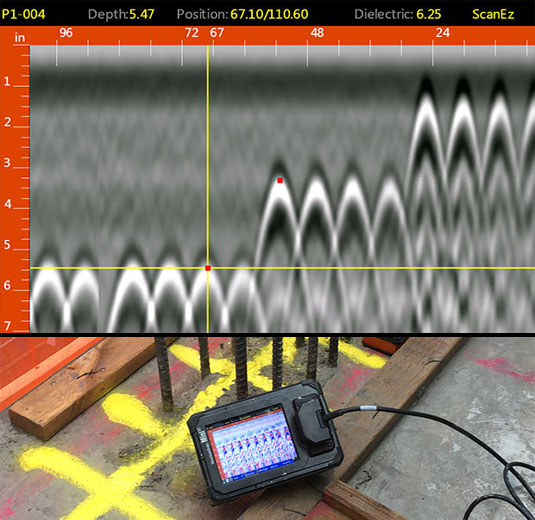Enhancing Project Preparation and Implementation With Advanced Concrete Scanning Techniques
In the world of job preparation and insight, precision and implementation are crucial elements that can make the distinction in between success and obstacles. Advanced concrete scanning techniques have actually become an innovative tool set to boost the standards of project monitoring within the building industry. By taking advantage of innovative innovation, these techniques use a peek right into the structural integrity of a structure even prior to the initial brick is laid. The effects of such innovations are extensive, assuring a paradigm change in how jobs are approached and delivered.
Advantages of Advanced Concrete Scanning Techniques

Improved Precision in Job Assessments
Enhancing project assessments through innovative concrete scanning strategies substantially improves the precision and integrity of building and construction evaluations. By utilizing advanced scanning technologies such as ground-penetrating radar (GPR) and 3D imaging, task teams can now get comprehensive insights into the problem of concrete structures, recognizing prospective defects or weak points that may not be visible to the nude eye. This enhanced degree of accuracy in task analyses allows construction specialists to make more enlightened decisions pertaining to repair service and upkeep techniques, bring about enhanced total job end results.
Additionally, the enhanced accuracy in job analyses accomplished via advanced concrete scanning methods helps in lessening the risk of unanticipated issues during the building and construction phase. By proactively identifying covert abnormalities within concrete structures, such as rebar rust or gaps, project teams can attend to these concerns at an early stage, staying clear of pricey hold-ups and rework later on in the task lifecycle. Eventually, the boosted accuracy in project evaluations promoted by advanced concrete scanning methods adds to higher effectiveness, cost-effectiveness, and top quality in construction projects.
Early Identification of Architectural Challenges
Early detection of architectural obstacles plays a crucial role in making sure the honesty and safety of concrete structures throughout the building process. Determining prospective problems at a very early phase permits for prompt treatment, preventing costly rework, schedule hold-ups, and safety and security dangers. Advanced concrete scanning strategies, such as ground-penetrating radar (GPR) and 3D imaging, make it possible for task groups to discover concealed flaws, spaces, support format disparities, and various other abnormalities that might jeopardize the structure's stability.
By executing these methods during the preparation and implementation stages, building experts can proactively attend to architectural difficulties before they escalate right into significant issues. As an example, identifying poor concrete cover over reinforcement bars at an early stage can avoid corrosion and architectural weakening in the long run - RainierGPR Service Areas. Additionally, determining variations in concrete thickness or thickness can help maximize material usage and guarantee uniform toughness homes across the framework
Eventually, very early recognition of architectural challenges via sophisticated concrete scanning not just improves the overall top quality and longevity of the building and construction but additionally contributes to a more secure developed environment for users and passengers.
Enhanced Precaution in Building And Construction
The implementation of robust safety and security procedures is imperative in the construction sector to alleviate dangers and safeguard the health of stakeholders and workers. To boost security steps, building and construction business are increasingly adopting technical developments such as wearable devices that monitor employees' important indicators and find prospective wellness problems in real-time. By prioritizing safety and security with the incorporation of sophisticated technologies and thorough training programs, building tasks can substantially decrease crashes and produce a safe and secure working setting for all involved.
Streamlining Job Management Processes
To maximize operational performance and ensure job success in the construction market, an emphasis on improving task management procedures is essential. By executing reliable project administration procedures, building jobs can decrease delays, decrease prices, and boost overall find more info efficiency. One key element of enhancing task management is using sophisticated modern technologies such as Building Info Modeling (BIM) software program, which allows real-time partnership, clash discovery, and exact task organizing. In addition, the adoption of cloud-based project administration systems enables smooth interaction amongst staff member, immediate access to job data, and the capability to track development in real-time.

Final Thought
Finally, the usage of sophisticated concrete scanning methods provides numerous benefits for task preparation and execution. These techniques provide better accuracy in project analyses, early recognition of architectural difficulties, enhanced precaution in building, and structured go to this web-site project monitoring procedures. Incorporating these techniques right into project workflows can inevitably cause much more efficient and effective end results in building tasks.
Inevitably, the improved precision in job assessments promoted by sophisticated concrete scanning strategies contributes to greater efficiency, cost-effectiveness, and high quality in construction tasks. RainierGPR Service Areas.
To optimize functional efficiency and guarantee task success in the building and construction market, an emphasis on improving task management procedures is important. By applying efficient job monitoring procedures, building tasks can reduce hold-ups, reduce expenses, and enhance total productivity. By enhancing task management procedures via technology combination, clear interaction, and data-driven methods, building and linked here construction projects can accomplish better performance, cost-effectiveness, and successful results.
These methods give enhanced precision in task analyses, early identification of structural difficulties, boosted safety and security steps in building and construction, and structured task management processes.